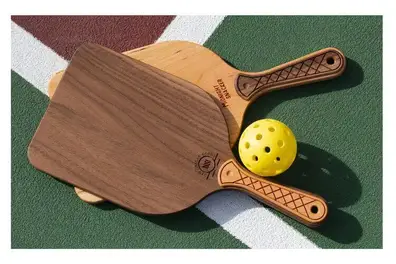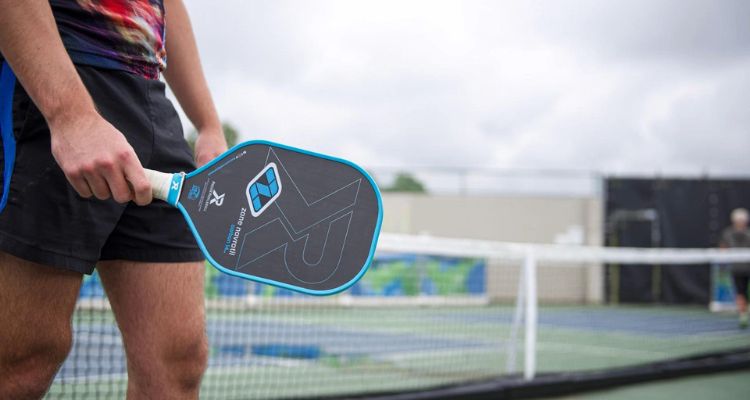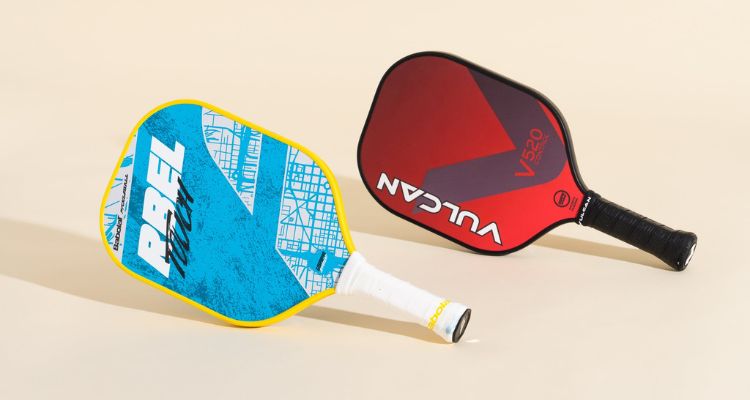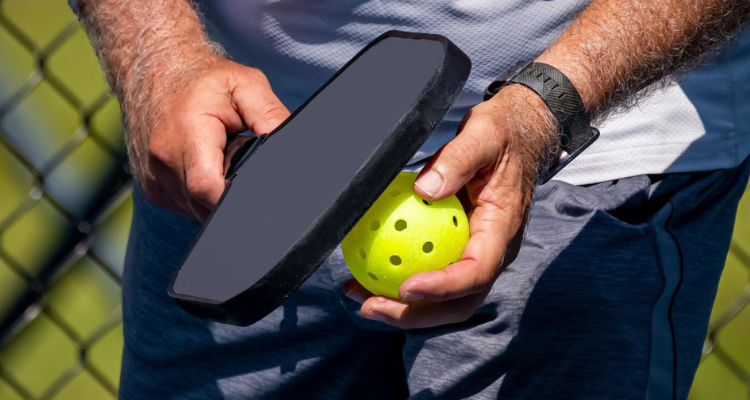Pickleball is a fun and exciting sport that combines elements of tennis, badminton, and ping-pong. It can be played by people of all ages and skill levels, indoors or outdoors, on a court similar to a tennis court. But to enjoy this game, you need a good pickleball racket.
A pickleball racket, also known as a paddle, is the most important piece of equipment in pickleball. It can make a big difference in your performance, comfort, and enjoyment of the game. But how do you choose the best pickleball racket for you?
There are many factors to consider when buying a pickleball racket, such as the size, shape, weight, material, core, surface, grip, and price. In this guide, we will explain each of these factors in detail and give you some tips on how to find the perfect pickleball rackets for your needs and preferences.

Size and Shape
The size and shape of a pickleball racket affect its maneuverability, reach, and sweet spot. The maneuverability is how easy it is to swing and control the racket 🏓. The reach is how far you can extend the racket to hit the ball. The sweet spot is the area on the racket face that produces the best contact and feel when hitting the ball.
The size and shape of a pickleball racket are regulated by the USA Pickleball Association (USAPA), the governing body of the sport. According to the USAPA rules, a pickleball racket cannot exceed 24 inches in total length, including the handle and the face. The width of the racket face cannot exceed 8.5 inches. The combined length and width of the racket face cannot exceed 24 inches.
Within these limits, there are various shapes of pickleball rackets available, such as square, rectangular, oval, circular, and teardrop. The most common shapes are square and rectangular, which offer a large and balanced sweet spot. Oval and circular shapes have a smaller and more concentrated sweet spot, which may provide more power and spin. Teardrop shapes have a longer and narrower face, which may increase the reach and maneuverability.
The size and shape of a pickleball racket depend largely on your personal preference and playing style. If you are a beginner or an intermediate player, you may want to choose a larger and more forgiving racket that has a bigger sweet spot and more stability. If you are an advanced or a competitive player, you may prefer a smaller and more responsive racket that has more control and precision.
Weight
The weight of a pickleball racket affects its balance, power, and control. The balance is how the weight is distributed between the handle and the face of the racket. The power is how hard and fast you can hit the ball. The control is how accurately and consistently you can place the ball.
The weight of a pickleball racket ranges from 6 to 14 ounces, with the average being around 8 ounces. The weight of a pickleball racket is determined by the material and the thickness of the core and the surface. Generally speaking, heavier rackets are more powerful and stable, while lighter rackets are more maneuverable and agile.
The weight of a pickleball racket 🏓 is also a matter of personal preference and playing style. If you are a beginner or an intermediate player, you may want to choose a lighter racket that is easier to swing and control. If you are an advanced or a competitive player, you may opt for a heavier racket that has more power and stability. However, you should also consider your physical condition and comfort level when choosing the weight of your racket. A racket that is too heavy or too light may cause fatigue, injury, or poor performance.

Material
The material of a pickleball rackets affects its durability, stiffness, and feel. The durability is how long the racket lasts and resists wear and tear. The stiffness is how rigid or flexible the racket is. The feel is how the racket vibrates and transfers energy when hitting the ball.
The material of a pickleball racket consists of two parts: the core and the surface. The core is the inner layer of the racket that provides the structure and the cushioning. The surface is the outer layer of the racket that covers the core and contacts the ball.
Core
The core of a pickleball racket is usually made of one of the following materials: polymer, aluminum, or nomex. Polymer is the most common and popular material for the core of a pickleball racket. It is a type of plastic that is lightweight, durable, and soft. It offers a good balance of power and control, and a quiet and smooth feel. Aluminum is a metal that is heavier, stiffer, and harder than polymer. It provides more power and stability, but less control and feel. It also makes a louder and sharper sound when hitting the ball. Nomex is a synthetic fiber that is lighter, thinner, and harder than polymer and aluminum. It delivers the most power and speed, but the least control and feel. It also produces the loudest and harshest sound when hitting the ball.
The core of a pickleball racket🏓 also varies in thickness, which affects its performance and feel. The thickness of the core of a pickleball racket ranges from 1/8 inch to 1/2 inch, with the average being around 3/8 inch. Generally speaking, thicker cores are softer and quieter, while thinner cores are harder and louder. Thicker cores also have more cushioning and forgiveness, while thinner cores have more responsiveness and feedback.
The material and the thickness of the core of a pickleball racket depend on your personal preference and playing style. If you are a beginner or an intermediate player, you may want to choose a polymer core that has a moderate thickness and a balanced performance and feel. If you are an advanced or a competitive player, you may prefer an aluminum or a nomex core that has a thinner thickness and a more powerful and aggressive performance and feel.
Surface
The surface of a pickleball racket is usually made of one of the following materials: fiberglass, carbon fiber, or graphite. Fiberglass is a type of glass that is flexible and durable. It offers more power and spin, but less control and feel. It also has a rough and textured surface that helps grip the ball and create spin. Carbon fiber is a type of plastic that is stiff and strong. It provides more control and feel, but less power and spin. It also has a smooth and glossy surface that reduces friction and increases speed. Graphite is a type of carbon that is lighter and thinner than carbon fiber. It has similar characteristics as carbon fiber, but with more responsiveness and feedback.
The surface of a pickleball racket also varies in texture, which affects its performance and feel. The texture of the surface of a pickleball racket ranges from smooth to rough, with the average being somewhere in between. Generally speaking, smoother surfaces are faster and slicker, while rougher surfaces are slower and grippier. Smoother surfaces also have less friction and vibration, while rougher surfaces have more friction and vibration.
The material and the texture of the surface of a pickleball rackets depend on your personal preference and playing style. If you are a beginner or an intermediate player, you may want to choose a fiberglass surface that has a moderate texture and a more forgiving and versatile performance and feel. If you are an advanced or a competitive player, you may opt for a carbon fiber or a graphite surface that has a smoother texture and a more precise and consistent performance and feel.
Grip
The grip of a pickleball racket affects its comfort, stability, and accuracy. The comfort is how the racket feels in your hand and prevents blisters and fatigue. The stability is how the racket stays in your hand and prevents slipping and twisting. The accuracy is how the racket aligns with your hand and wrist and affects your shot placement and direction.
The grip of a pickleball racket consists of two parts: the size and the shape. The size is the circumference of the handle, measured in inches. The shape is the cross-section of the handle, which can be round, oval, or octagonal.

Size
The size of the grip of a pickleball racket ranges from 4 to 4 1/2 inches, with the average being around 4 1/4 inches. The size of the grip of a pickleball rackets is determined by the diameter and the thickness of the handle and the grip tape. Generally speaking, smaller grips are more maneuverable and agile, while larger grips are more stable and secure.
The size of the grip of a pickleball rackets 🏓 is also a matter of personal preference and comfort. However, there is a simple way to measure the ideal grip size for your hand. To do this, hold your hand flat and measure the distance from the tip of your ring finger to the bottom lateral crease of your palm. This distance should match the grip size of your pickleball racket. For example, if the distance is 4 1/8 inches, then your ideal grip size is 4 1/8 inches.
Shape
The shape of the grip of a pickleball racket is usually round, oval, or octagonal. Round grips are the most common and traditional shape of pickleball racket grips. They are symmetrical and uniform, which makes them easy to rotate and adjust in your hand. Oval grips are slightly flattened on the sides, which makes them more ergonomic and comfortable in your hand. Octagonal grips have eight distinct edges, which makes them more textured and grippy in your hand.
The shape of the grip of a pickleball rackets is also a matter of personal preference and comfort. However, there are some advantages and disadvantages of each shape. Round grips are more versatile and adaptable, but they may also cause more blisters and fatigue. Oval grips are more comfortable and natural, but they may also limit your flexibility and adjustment. Octagonal grips are more textured and grippy, but they may also cause more friction and vibration.
The grip of a pickleball rackets is an important factor that affects your comfort, stability, and accuracy. You should choose the grip size and shape that fit your hand and suit your playing style. You can also customize your grip by adding or removing grip tape, or by using an overgrip or a cushion grip.
Price
The price of a pickleball racket is another factor that you should consider when buying a pickleball rackets. The price of a pickleball rackets ranges from $20 to $200, with the average being around $80. Price of a pickleball racket is determined by the quality and the features of the racket, such as the material, the core, the surface, the grip, and the design.
Generally speaking, more expensive rackets are more durable, stiff, and light, while cheaper rackets are less durable, flexible, and heavy. More expensive rackets 🏓 also have more advanced and innovative features, such as edge guards, shock absorbers, and honeycomb cores, while cheaper rackets have more basic and standard features, such as wood cores, vinyl surfaces, and perforated grips.

The price of a pickleball racket is also a matter of personal preference and budget. However, you should not compromise on the quality and the performance of your racket for the sake of saving money. You should invest in a good pickleball racket that meets your needs and preferences, and that will last for a long time. You can also look for discounts, sales, and bundles to get the best value for your money.
FAQs
Here are some frequently asked questions and answers about pickleball rackets.
What is the difference between a pickleball racket and a tennis racket?
A pickleball racket and a tennis racket are different in many ways, such as the size, the weight, the material, the core, the surface, the grip, and the string. Pickleball racket is smaller, lighter, stiffer, and harder than a tennis racket. A pickleball racket has a solid core and a smooth surface, while a tennis racket has a hollow core and a stringed surface. A pickleball racket has a smaller and rounder grip, while a tennis racket has a larger and octagonal grip.
How do I take care of my pickleball racket?
You should take good care of your pickleball racket to maintain its quality and performance. You should clean your racket regularly with a damp cloth or a mild soap, and dry it thoroughly. Should avoid exposing your racket to extreme temperatures, moisture, or sunlight, as they may damage or warp your racket. You should store your racket in a protective case or a bag, and keep it away from sharp or heavy objects. You should also inspect your racket for any cracks, dents, or peeling, and replace it if necessary.
How do I improve my pickleball skills with my racket?
You can improve your pickleball skills with your racket by practicing regularly and consistently. You should practice with a partner or a coach, or join a club or a league, to get feedback and tips on your technique and strategy. You should also practice with different types of rackets, balls, and courts, to adapt to different conditions and situations. You should also watch and learn from other players, especially the pros, to get inspiration and motivation.
How do I choose the best pickleball racket for me?
You can choose the best pickleball racket for you by following this guide and considering the factors that we discussed, such as the size, the shape, the weight, the material, the core, the surface, the grip, and the price. You should also try out different rackets before buying one, to see how they feel and perform in your hand. You should also read reviews and ratings from other users, to get their opinions and experiences. You should also consult with a professional or an expert, to get their advice and recommendations.
Where can I buy a pickleball racket?
You can buy a pickleball racket from various sources, such as online stores, physical stores, or direct sellers. Online stores are convenient and offer a wide range of options, but you may not be able to test or inspect the racket before buying it. Physical stores are more reliable and allow you to try and examine the racket before buying it, but they may have limited stock or higher prices. Direct sellers are trustworthy and offer personalized service and support, but they may have fewer choices or longer delivery times.
Conclusion
Pickleball is a fun and exciting sport that requires a good pickleball racket. A pickleball racket is the most important piece of equipment in pickleball, as it affects your performance, comfort, and enjoyment of the game. To choose the best pickleball racket for you, you should consider the factors that we discussed in this guide, such as the size, the shape, the weight, the material, the core, the surface, the grip, and the price.
You should also try out different rackets, read reviews and ratings, and consult with professionals or experts. By doing so, you will be able to find the perfect pickleball racket for your needs and preferences, and have a great time playing pickleball. 🏓




